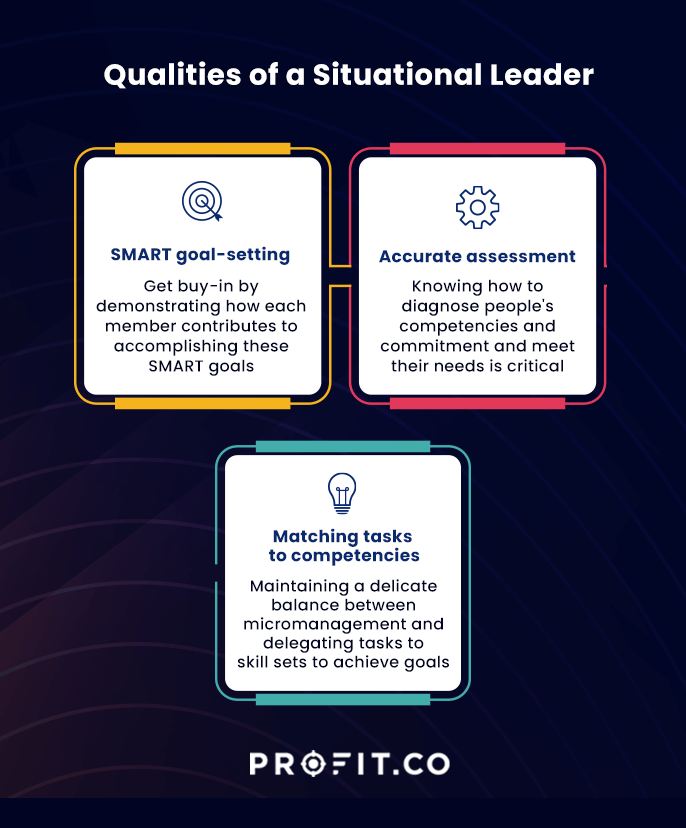Introduction
Leaders can effectively guide the organization to phenomenal success or drive it down to nothing. Historically great leaders have evolved in the business community, and many leadership styles have emerged.
So What is Leadership Style?
A leadership style defines how a person guides, motivates and manages a group. Good leaders inspire action and innovation toward a common goal, but each leader’s style differs. This guide looks at situational leadership and how it applies to organizations today.
Are you a leader at a crossroads trying to navigate your team toward success? Then you are right where you need to be. Read along for pro tips and time-tested models to motivate you and your team to success.
Situational Leadership
Situational leadership definition
Situational leadership is a theory that depends on an organization’s context. Rather than solely relying on their leadership skills or abilities, influential situational leaders adapt to their environment based on the nature of tasks and teams. A situational leader considers the variables surrounding each decision and adjusts their leadership style to complete the work.
This situational leadership definition is also called the Hersey-Blanchard theory, named after Dr. Paul Hersey and Kenneth Blanchard, authors of “The Situational Leader” and “One-minute Manager”, respectively. Situational leadership differs from other leadership styles because it combines techniques that depend on the leader’s environment and their team’s commitment and competence.
Hersey-Blanchard situational leadership models
The situational approach to leadership comprises four leadership styles:
- Style 1: Telling
- Style 2: Selling
- Style 3: Participating
- Style 4: Delegating
The telling style (S1) means that the leader makes the decisions and tells the team how to execute them. It relies on the leader’s close supervision and specific guidance. This style is a one-way delegation from leaders to their teams, making it ideal for managing a disaster or gaining repetitive results.
The selling style (S2) seeks to gain cooperation or buy-in. Leaders communicate or ” sell their ideas and listen to the team’s feedback. It involves persuasion, explanation, and response. This back-and-forth style works best to motivate teams toward the leader’s objectives.
The participating style (S3) gives the team a more active role in decision-making. It involves facilitating, sharing, and encouraging autonomy. Leaders offer their expertise but leave the decision to the team, aiming to give them the confidence to perform their tasks.
The delegating style (S4) has less involvement from leadership as the team takes responsibility for their choices. It requires a more hands-off approach with effective and efficient teams. Even though leaders let their teams make decisions, they remain available for guidance occasionally.
In addition to these leadership styles, situational leadership also categorizes a team’s competence and knowledge into four maturity levels:
- Teams at the M1 level lack the skills, knowledge, and willingness to undertake the tasks their leaders require.
- Teams at the M2 level are willing but unable to undertake the tasks.
- Teams at the M3 level can undertake the job but are unwilling to be responsible for their choices.
- Teams at the M4 level are highly skilled, willing, and able to complete their tasks.
For situational leadership to work effectively, leaders must match the style to the maturity levels to achieve organizational goals. Low-maturity teams respond best to a telling leadership style (M1 to S1). In contrast, a highly competent team responds best to a delegating leadership style (M4 to S4). It’s up to the leader to understand where their teams lie on the maturity scale and adapt their approach accordingly.
I suppose leadership at one time meant muscles, but today it means getting along with people.
How does situational leadership work?
Let’s look at how a situational approach to leadership applies to project management. A project brings together a range of individuals with different competencies that must work toward a clear objective. Situational leadership grants the flexibility needed to move from the project’s beginning to completion.
For example, a selling style is best when seeking buy-in and support from stakeholders for a project. On the other hand, a telling style works when the project kicks off since teams may not know how to balance project requirements and their everyday operational tasks. As the project progresses and teams become more competent, leaders can shift to a delegating style.
Based on this example, the Hersey-Blanchard situational leadership theory acknowledges that business contexts are complex and dynamic; leaders must accommodate these differences to be highly effective in their efforts. Situational leadership involves effective people management skills. The best leaders “read the room” and choose a style that matches the situation, which might change by the day, project type, available talent, and many other factors.
Situational leadership examples
Situational leadership also applies in the following contexts:
- Emergency healthcare
Emergency room teams face numerous daily challenges, but pressure escalates significantly during disruptions like natural disasters or, more recently, a global pandemic. Emergency room supervisors must factor in the medical teams and patients in every decision they make. Sometimes, a telling style is ideal for directing the team under pressure. At other times, a delegating style is best for referring patients to specialists to support their care further.
- Advocacy
Running an advocacy campaign means adapting your message to match various stakeholders. A situational leader must appeal to multiple audiences, from political and social leaders to everyday individuals and vulnerable groups, to get support for their cause. It also means working with a team with different competencies, from legal affairs to digital marketing. Given the dynamic nature of advocacy, a situational leader can use telling, selling, participating, and delegating styles at any given time during the campaign.
- Education
Leaders in the education sector juggle various roles, such as problem-solving, fundraising, and community-building. These contexts present dynamic challenges that a situational approach to leadership can overcome. School principals and university presidents deal with separate groups with unique agendas and priorities. Therefore, these educational leaders can balance their strategy by delegating specific roles to competent staff or using a telling or selling style when engaging donors and well-wishers.

Qualities of a situational leader
- SMART goal-setting
Set specific, measurable, achievable, realistic, and time-bound goals to motivate your team. Use these goals to assess your team’s performance and effectively communicate your decisions. Get buy-in by demonstrating how each member contributes to accomplishing these SMART goals.
- Accurate assessment
Situational leaders know how to diagnose their team members’ competencies and commitment levels accurately. In any project, you’ll encounter independent and creative thinkers, knowledgeable but cautious group members, and individuals with few skills but enthusiastic about learning. Knowing how to tell these people apart and meet their needs is a critical situational leadership skill.
- Matching Tasks to Competencies
As a situational leader, understanding the skills of team members is critical to assign tasks. Highly competent team members respond poorly to micromanagement, while underskilled or low-confidence members disengage further under delegation styles. This is a delicate balance to achieve, and it takes years of experience in situational leadership to get it right.
Advantages and disadvantages of situational leadership
The Hersey-Blanchard situational leadership model is an intuitive leadership style that enables a comfortable working environment for teams at all maturity levels. Since situational leaders match the team’s needs, there’s a higher level of motivation and confidence when following instructions and making independent decisions.
On the other hand, a constantly changing leadership style may lead to confusion, particularly if the leader misjudges the team’s abilities. Situational leadership is also unsuitable for long-term goals, repetitive tasks, or projects requiring new talent at various phases. An effective goal management platform like an agile OKR software can help manage the teams systematically. Many leadership OKR examples can be used by leaders to manage the goals of their teams to achieve seamless strategy execution.
FAQs
- What is situational leadership?
Situational leadership is a theory that encourages leaders to adapt their skills to match their teams’ unique abilities to get the best performance.
- Name the four styles of situational leadership.
The four situational leadership styles are telling, selling, participating, and delegating.
- What are the three skill sets of situational leadership?
The three essential situational leadership skills are setting SMART goals, accurately assessing teams’ abilities, and matching those abilities to the right tasks.
- What is an example of situational leadership?
An example of situational leadership is project management, where leaders adapt their leadership style according to different project phases. The beginning of a project may require a telling style, while the end may require a delegating style.
Conclusion
The Hersey-Blanchard situational leadership model encourages leaders to base their decisions on their teams’ level of commitment and competence. Consider whether your current project requires a telling, selling, participating, or delegating leadership style or a mix of these approaches. Prioritize your team and organizational goals for successful situational leadership.
To learn more about leadership competencies try Profit.co for free



